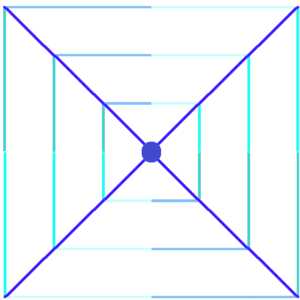
Incorrect placement can lead to root rot or root balling. Uneven placement can lead to dry spots in some places and water wastage in others. Mulch and good soil structure can mitigate this to some extent, by encouraging even distribution of moisture content within the soil.
Use with square hedges[edit | edit source]
Normally, in arid areas, hedges are placed in a spiraling setup. The intent of this is to give each plant partial protection from its neighbour, while encircling the area, hence making it larger and less windy with every pass. -->Not sure whether planted inwards (inwards spiral) or outwards, inwards would make more sense, as this would provide most protection for the newer plants (which are younger), where the older ones take the bulk of the wind.
However, giving that this method is difficult to achieve accuratly (perfect spirals are hard to accomplish) and due to the fact that a spiral does not allow good land use afterwards (ie planting of crops between the hedges), square hedges are best used.
Square hedges also allow a much more efficient drip line system to be set up, right along the square, extending from a well/water reservoir. In order to allow good detection of leaks, several lines are best used, as well as a good pattern, with sensors on the junctions
The electronics[edit | edit source]
The most simple drip line system uses a simple time switch for connecting/disconnecting the power for a specific duration. If the amount of waterflow is known, we can, with this time witch deliver precise amounts of water. See Open-source watering system, http://www.instructables.com/id/Automatic-Plant-Watering-Device-simple-version/